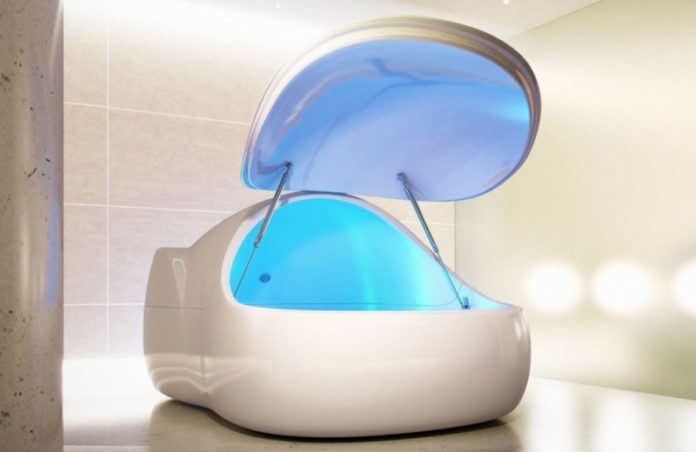Have you ever wanted to just float away from your problems? What if you could actually do that, for at least a little while? Float clinics are popping up in cities across the country and for good reason.
Anyone coping with everyday stress can reap the benefits of floating. But if you suffer from anxiety, depression, PTSD, or chronic pain this might be the one therapy you haven’t tried yet. According to Men’s Health magazine, many professional athletes swear by it, too.
The concept is quite simple. You lie in a pod or a small pool filled with hundreds of pounds of Epsom salt dissolved in shallow, body temperature water and just float. The experience brings the individual to a meditative state. Is it time to try floating?
Is Floating the Same as Sensory Deprivation?
The modern world is filled with sensory overload. Computers, cell phones, advertising, and traffic fill the world with sights, sounds, smells, and feelings. Sometimes, we need a break.
Sensory deprivation dates to the 1950s. It seems only recently, someone chose to rebrand it as floating.
Sensory deprivation removes stimulation to two of our most commonly overloaded senses: sight and sound. The soundproof pod blocks both light and noise. The body temperature water removes any touch sensation. Ideally, no scent is present either.
The complete lack of sensory stimulation can be too much for some. As humans, we are always surrounded by some kind of noise–the humming of electricity, someone walking past our office, or distant traffic. If you’ve ever been startled by the sudden silence during a power outage, you have a sense of the contrast.
Modern float clinics can actually adjust the amount of stimulation. Some tanks or pods incorporate soft lights, music or nature sounds. Some enclose the person completely while some leave the top open to ward off claustrophobia.
Therapeutic Benefits of Floating
Time Magazine published an extensive story on floating research. As they explain, neuroscientist John C. Lilly was first to try the therapy on patients. However, he was known in the science community as a bit odd so the therapy wasn’t taken seriously. Scientist Tom H. Fine later sought funding but struggled to get it. It wasn’t until the 1990s that some of the taboo wore off and he was able to get any significant funding for his research in sensory deprivation.
Since then a lot of research has been done to study how floating can help patients who suffer from mental illnesses. The Time article mentioned above follows a soldier with PTSD. After self-medicating with drugs and alcohol he followed his wife’s suggestion to find alternative therapies. “To me, it seemed like a sham,” he said. Then, after his first experience, he felt completely different about it stating, “I’m not really sure how it does it, but I do know that floating has allowed me to feel in a more confident, comfortable headspace.”
Neuropsychologist Justin Feinstein ran a study by attaching waterproof EEGs to volunteers as they lay in the float tanks. He found, as I have written before, that meditation activates parts of the brain associated with attention and memory while decreasing activity in the area associated with anxiety and fear.
Feinstein doesn’t just monitor the brain. He also tests the volunteers’ blood. His research shows that floating for 60-90 minutes reduces cortisol, a hormone the body releases when it experiences stress. The constant release of cortisol into our bloodstream can raise bad cholesterol. It has also been shown to increase blood pressure.
Other studies have looked at potential benefits of floating for eating disorders, smoking cessation, and even enhancing creativity.
Drawbacks to Floating
Some users describe the floating pod as “coffin-like.” Those with claustrophobia may not get the full benefit of the therapy. However, others state that due to the darkness you can’t tell that you are in a confined space. Also, as mentioned above, you do not have to shut the lid.
Others have complained that they kept floating into the side of the pod, which distracted them from their meditative state. The water itself could also be a point of contention for some because it is so salty. When you’re still trying to get used to floating in the tank it’s hard to keep the water from getting in your eyes. If you’ve ever gotten salt water in your eyes, you know that is not a pleasant feeling.
Modern float clinics charge a premium. For instance, floating at Tao Float Loft, based near Cincinnati, Ohio, costs $59 for the first visit. They do try to work with customers on cost by putting together packages. They said in an interview with CincyChic.com “For those who suffer from chronic pain, there is an option to float for $37 for 1 hour with a doctor’s note or recent documentation stating the condition you suffer from.” Some yoga studios and physical therapy studios are beginning to install float tanks, too.
More research needs to be done to find the full effects of floating. So if you’d like to try it out for yourself you may want to talk to your doctor first. Whether you suffer from a chronic condition or just want to satisfy your curiosity, you may enjoy it. If you have tried it, let us know what you think. We’d love to hear about your experience.
PHOTO: By Floatguru / CC BY-SA 3.0, via Wikimedia Commons








